Geomorphometric Characterization of Pockmarks by Using a GIS-Based Semi-Automated Toolbox
Abstract
:1. Introduction
2. Materials and Methods
2.1. Study Areas and Datasets
2.1.1. Witch Ground Basin–North Sea (UK)
2.1.2. Malin Basin (Ireland)
2.1.3. Barents Sea (Norway)
2.2. Manual Mapping
2.3. Pixel-Based Calculation of Terrain Attributes as a Basis for Semi-Automated Mapping
2.4. BGS Seabed Mapping Toolbox
2.4.1. Data Preparation
2.4.2. Feature Delineation
2.5. Morphometric Analysis
3. Results
3.1. Witch Ground Basin—North Sea
Comparison between the Results from the BGS Semi-Automatic Approach and from the Pixel-Based Analysis
3.2. Malin Basin
Comparison between the Results from the BGS Semi-Automatic Approach and from Manual Mapping
3.3. Barents Sea
3.4. Geomorphometric Comparison between the Different Areas
4. Discussion
4.1. Importance of Pockmarks Geomorphometric Characterization
4.2. Impact of Data Resolution and Quality
4.3. Impact of Regional Morphology
4.4. Mapping Strategies at Multiple Scales
5. Conclusions
Supplementary Materials
Author Contributions
Acknowledgments
Conflicts of Interest
References
- King, L.H.; MacLean, B. Pockmarks on the Scotian Shelf. Bull. Geol. Soc. Am. 1970, 81, 3141–3148. [Google Scholar] [CrossRef]
- Martínez-Carreño, N.; García-Gil, S. The Holocene gas system of the Ría de Vigo (NW Spain): Factors controlling the location of gas accumulations, seeps and pockmarks. Mar. Geol. 2013, 344, 1–19. [Google Scholar] [CrossRef]
- Olu-Le Roy, K.; Caprais, J.C.; Fifis, A.; Fabri, M.C.; Galéron, J.; Budzinsky, H.; Le Ménach, K.; Khripounoff, A.; Ondréas, H.; Sibuet, M. Cold-seep assemblages on a giant pockmark off West Africa: Spatial patterns and environmental control. Mar. Ecol. 2007, 28, 115–130. [Google Scholar] [CrossRef]
- Hovland, M.; Judd, A.G.; King, L.H. Characteristic features of pockmarks on the North Sea Floor and Scotian Shelf. Sedimentology 1984, 31, 471–480. [Google Scholar] [CrossRef]
- Pilcher, R.; Argent, J. Mega-pockmarks and linear pockmark trains on the West African continental margin. Mar. Geol. 2007, 244, 15–32. [Google Scholar] [CrossRef]
- Dandapath, S.; Chakraborty, B.; Karisiddaiah, S.M.; Menezes, A.; Ranade, G.; Fernandes, W.; Naik, D.K.; Prudhvi Raju, K.N. Morphology of pockmarks along the western continental margin of India: Employing multibeam bathymetry and backscatter data. Mar. Pet. Geol. 2010, 27, 2107–2117. [Google Scholar] [CrossRef]
- Gay, A.; Lopez, M.; Cochonat, P.; Sultan, N.; Cauquil, E.; Brigaud, F. Sinuous pockmark belt as indicator of a shallow buried turbiditic channel on the lower slope of the Congo basin, West African margin. Subsurf. Sediment Mobilization 2003, 216, 173–189. [Google Scholar] [CrossRef]
- Harrington, P.K. Formation of pockmarks by pore-water escape. Geo-Mar. Lett. 1985, 5, 193–197. [Google Scholar] [CrossRef]
- Gafeira, J.; Long, D.; Diaz-Doce, D. Semi-automated characterisation of seabed pockmarks in the central North Sea. Near Surf. Geophys. 2012, 10, 301–312. [Google Scholar] [CrossRef] [Green Version]
- De Clippele, L.H.; Gafeira, J.; Robert, K.; Hennige, S.; Lavaleye, M.S.; Duineveld, G.C.A.; Huvenne, V.A.I.; Roberts, J.M. Using novel acoustic and visual mapping tools to predict the small-scale spatial distribution of live biogenic reef framework in cold-water coral habitats. Coral Reefs 2017, 36, 255–268. [Google Scholar] [CrossRef]
- Sejrup, H.P.; Haflidason, H.; Aarseth, I.; King, E.; Forsberg, C.F.; Long, D.; Rokoengen, K. Late Weichselian glaciation history of the northern North Sea. Boreas 1994, 23, 1–13. [Google Scholar] [CrossRef]
- Barkan, R.; Chaytor, J.D.; Andrews, B.D. Size distributions and failure initiation of submarine and subaerial landslides. Earth Planet. Sci. Lett. 2009, 287, 31–42. [Google Scholar] [CrossRef]
- Long, D. Devensian late-glacial gas escape in the central North Sea. Cont. Shelf Res. 1992, 12, 1097–1110. [Google Scholar] [CrossRef]
- Judd, A. Pockmarks in the UK Sector of the North Sea. 2001. Available online: https://assets.publishing.service.gov.uk/government/uploads/system/uploads/attachment_data/file/197337/TR_SEA2_Pockmarks_Dist.pdf (accessed on 26 April 2018).
- Gafeira, J.; Long, D. Geological Investigation of Pockmarks in the Scanner Pockmark SCI Area; JNCC Report No 570; Joint Nature Conservation Committee (JNCC): Peterborough, UK, 2015.
- Stoker, M.S.; Hitchen, K.; Graham, C.C. The Geology of the Hebrides and West Shetland Shelves, and Adjacent Deep-Water Areas; United Kingdom Offshore Reginal Report; HMSO: Richmond, UK, 1993; p. 149.
- Evans, D.; Whittington, R.J.; Dobson, M.R. Tiree Sheet 56 N—08 W Quaternary Geology; British Geological Survey: Edinburgh, UK, 1987. [Google Scholar]
- Szpak, M. Chemical and Physical Dynamics of Marine Pockmarks with Insights into the Organic Carbon Cycling on the Malin Shelf and in the Dunmanus Bay. Ireland. Ph.D. Thesis, Dublin City University, Dublin, UK, 2012. [Google Scholar]
- Rise, L.; Bellec, V.K.; Ch, S.; Bøe, R. Pockmarks in the southwestern Barents Sea and Finnmark fjords. Nor. J. Geol. 2014, 94, 263–282. [Google Scholar] [CrossRef]
- Horn, B.K.P. Hill Shading and the Reflectance Map. Proc. IEEE 1981, 69, 14–47. [Google Scholar] [CrossRef]
- Wood, J. The Geomorphological Characterisation of Digital Elevation Models. Ph.D. Thesis, University of Leicester, Leicester, UK, 1996. [Google Scholar]
- Wright, D.J.; Pendleton, M.; Boulware, J.; Walbridge, S.; Gerlt, B.; Eslinger, D.; Sampson, D.; Huntley, E. ArcGIS Benthic Terrain Modeler (BTM), v. 3.0; Environmental Systems Research Institute, NOAA Coastal Services Center, Massachusetts Office of Coastal Zone Management. Available online: http://esriurl.com/5754 (accessed on 26 April 2018).
- Wilson, M.F.J.; O’Connell, B.; Brown, C.; Guinan, J.C.; Grehan, A.J. Multiscale Terrain Analysis of Multibeam Bathymetry Data for Habitat Mapping on the Continental Slope. Mar. Geodesy 2007, 30, 3–35. [Google Scholar] [CrossRef]
- Zevenbergen, L.W.; Thorne, C.R. Quantitative analysis of land surface topography. Surf. Process. Landf. 1987, 12, 47–56. [Google Scholar] [CrossRef]
- Geldof, J.; Gafeira, J.; Contet, J.; Marquet, S. GIS Analysis of Pockmarks From 3D Seismic Exploration Surveys. In Proceedings of the Offshore Technology Conference, Houston, TX, USA, 5–8 May 2014; pp. 1–10. [Google Scholar]
- Jorge, M.G.; Brennand, T.A. Semi-automated extraction of longitudinal subglacial bedforms from digital terrain models—Two new methods. Geomorphology 2017, 288, 148–163. [Google Scholar] [CrossRef]
- Hovland, M.; Sommerville, J.H. Characteristics of two natural gas seepages in the North Sea. Mar. Pet. Geol. 1985, 2, 319–326. [Google Scholar] [CrossRef]
- Dando, P.R.; Austen, M.C.; Burke, R.A.; Kendall, M.A.; Kennicutt II, M.C.; Judd, A.G.; Moore, D.C.; O’Hara, S.C.M.; Schmaljohann, R.; Southward, A.J. Ecology of a North Sea pockmark with an active methane seep. Mar. Ecol. Prog. Ser. 1991, 70, 49–63. [Google Scholar] [CrossRef]
- Judd, A.; Long, D.; Sankey, M. Pockmark formation and activity, UK block 15/25, North Sea. Bull. Geol. Soc. Den. 1994, 41, 34–49. [Google Scholar] [CrossRef]
- Walbridge, S.; Slocum, N.; Pobuda, M.; Wright, D.J. Unified Geomorphological Analysis Workflows with Benthic Terrain Modeler. Geosciences 2018, 8, 94. [Google Scholar] [CrossRef]
- Jasiewicz, J.; Stepinski, T.F. Geomorphons-a pattern recognition approach to classification and mapping of landforms. Geomorphology 2013, 182, 147–156. [Google Scholar] [CrossRef]
- Monteys, X.; Hardy, D.; Doyle, E.; Garcia-Gil, S. Distribution, morphology and acoustic characterisation of a gas pockmark field on the Malin Shelf, NW Ireland. In Symposium OSP-01, Proceedings of the 33rd International Geological Congress, Oslo, Norway, 6–14 August 2008; Curran Associates, Inc.: New York, NY, USA, 2008. [Google Scholar]
- Smith, M.J.; Wise, S.M. Problems of bias in mapping linear landforms from satellite imagery. Int. J. Appl. Earth Obs. Geoinf. 2007, 9, 65–78. [Google Scholar] [CrossRef]
- Smith, M.J.; Clark, C.D. Methods for the visualisation of digital elevation models for landform mapping. Earth Surf. Process. Landf. 2005, 30, 885–900. [Google Scholar] [CrossRef]
- Bishop, M.P.; James, L.A.; Shroder, J.F.; Walsh, S.J. Geospatial technologies and digital geomorphological mapping: Concepts, issues and research. Geomorphology 2012, 137, 5–26. [Google Scholar] [CrossRef]
- Reuter, H.I.; Wendroth, O.; Kersebaum, K.C. Optimisation of relief classification for different levels of generalisation. Geomorphology 2006, 77, 79–89. [Google Scholar] [CrossRef]
- MacMillan, R.A.; Shary, P.A. Landforms and Landform Elements in Geo-morphometry. Dev. Soil Sci. 2009, 33, 227–254. [Google Scholar] [CrossRef]
- Wieczorek, M.; Migoń, P. Automatic relief classification versus expert and field based landform classification for the medium-altitude mountain range, the Sudetes, SW Poland. Geomorphology 2014, 206, 133–146. [Google Scholar] [CrossRef]
- Lecours, V.; Dolan, M.F.J.; Micallef, A.; Lucieer, V.L. A review of marine geomorphometry, the quantitative study of the seafloor. Hydrol. Earth Syst. Sci. 2016, 20, 3207–3244. [Google Scholar] [CrossRef]
- Harrison, R.J.P.; Bellec, V.K.; Mann, D.; Wang, W. A new approach to the automated mapping of pockmarks in multi-beam bathymetry. In Proceedings of the 2011 18th IEEE International Conference on Image Process (ICIP), Brussels, Belgium, 11–14 September 2011; pp. 1–4. [Google Scholar]
- Di Stefano, M.; Mayer, L. An Automatic Procedure for the Quantitative Characterization of Submarine Bedforms. Geosciences 2018, 8, 28. [Google Scholar] [CrossRef]
- Masetti, G.; Mayer, L.; Ward, L. A Bathymetry- and Reflectivity-Based Approach for Seafloor Segmentation. Geosciences 2018, 8, 14. [Google Scholar] [CrossRef]
- Diesing, M.; Thorsnes, T. Mapping of Cold-Water Coral Carbonate Mounds Based on Geomorphometric Features: An Object-Based Approach. Geosciences 2018, 8, 34. [Google Scholar] [CrossRef]
- Diesing, M.; Green, S.L.; Stephens, D.; Lark, R.M.; Stewart, H.; Dove, D. Mapping seabed sediments: Comparison of manual, geostatistical, object-based image analysis and machine learning approaches. Cont. Shelf Res. 2014, 84, 107–119. [Google Scholar] [CrossRef] [Green Version]
- Lucieer, V.; Lamarche, G. Unsupervised fuzzy classification and object-based image analysis of multibeam data to map deep water substrates, Cook Strait, New Zealand. Cont. Shelf Res. 2011, 31, 1236–1247. [Google Scholar] [CrossRef]
- Sánchez-Guillamón, O.; Fernández-Salas, L.; Vázquez, J.-T.; Palomino, D.; Medialdea, T.; López-González, N.; Somoza, L.; León, R. Shape and Size Complexity of Deep Seafloor Mounds on the Canary Basin (West to Canary Islands, Eastern Atlantic): A DEM-Based Geomorphometric Analysis of Domes and Volcanoes. Geosciences 2018, 8, 37. [Google Scholar] [CrossRef]
- Gafeira, J.; Long, D. Geological Investigation of Pockmarks in the Braemar Pockmarks SCI and Surrounding Area; JNCC Report No. 571; Joint Nature Conservation Committee (JNCC): Peterborough, UK, 2015.
- Lecours, V.; Devillers, R.; Edinger, E.N.; Brown, C.J.; Lucieer, V.L. Influence of artefacts in marine digital terrain models on habitat maps and species distribution models: A multiscale assessment. Remote Sens. Ecol. Conserv. 2017, 3, 232–246. [Google Scholar] [CrossRef]
- Picard, K.; Radke, L.C.; Williams, D.K.; Nicholas, W.A.; Siwabessy, J.P.; Floyd, H.; Gafeira, J.; Przeslawski, R.; Huang, Z.; Nichol, S. Origin of high density seabed pockmark fields and their use in inferring bottom currents. Geosciences 2018, in press. [Google Scholar]
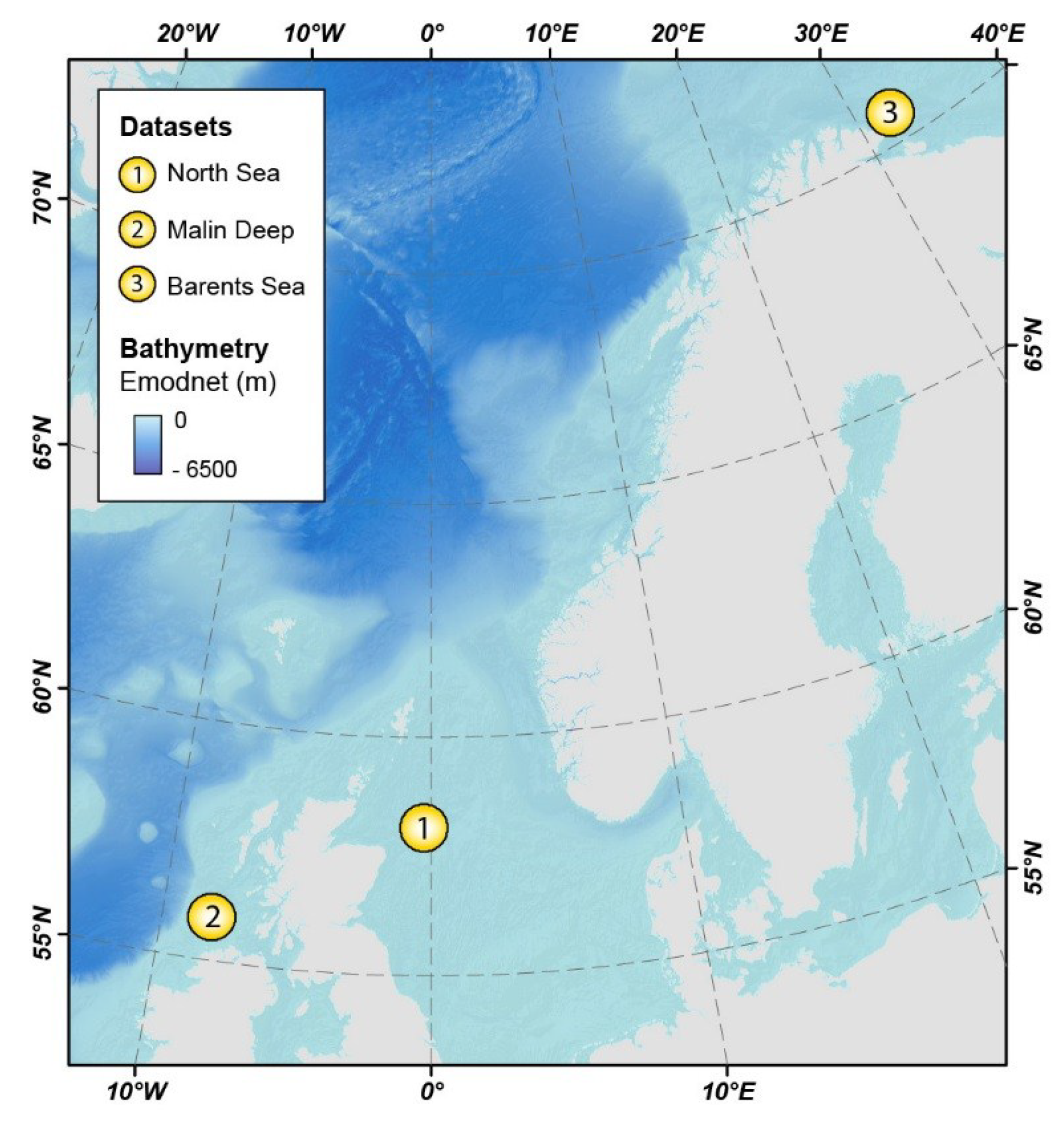
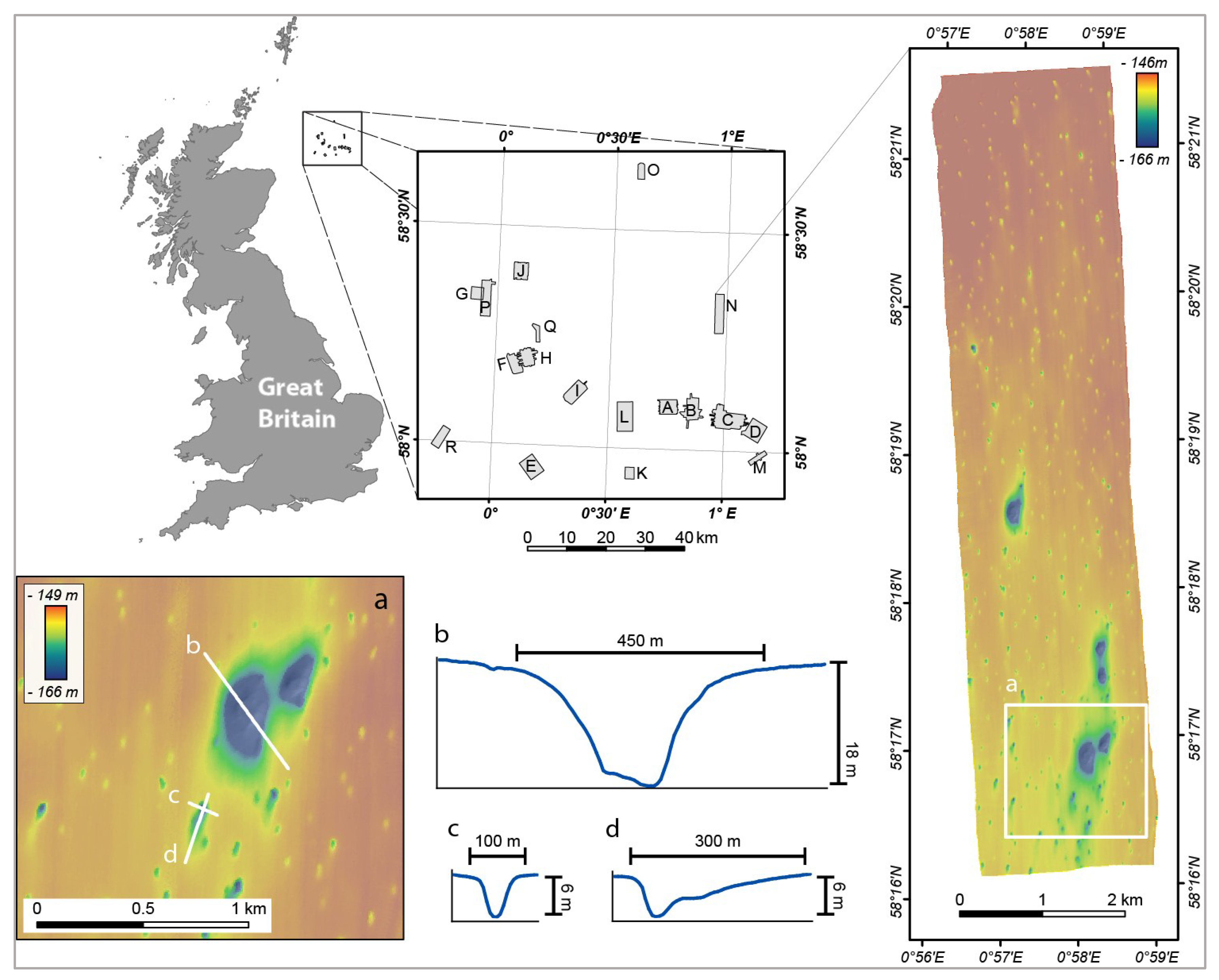
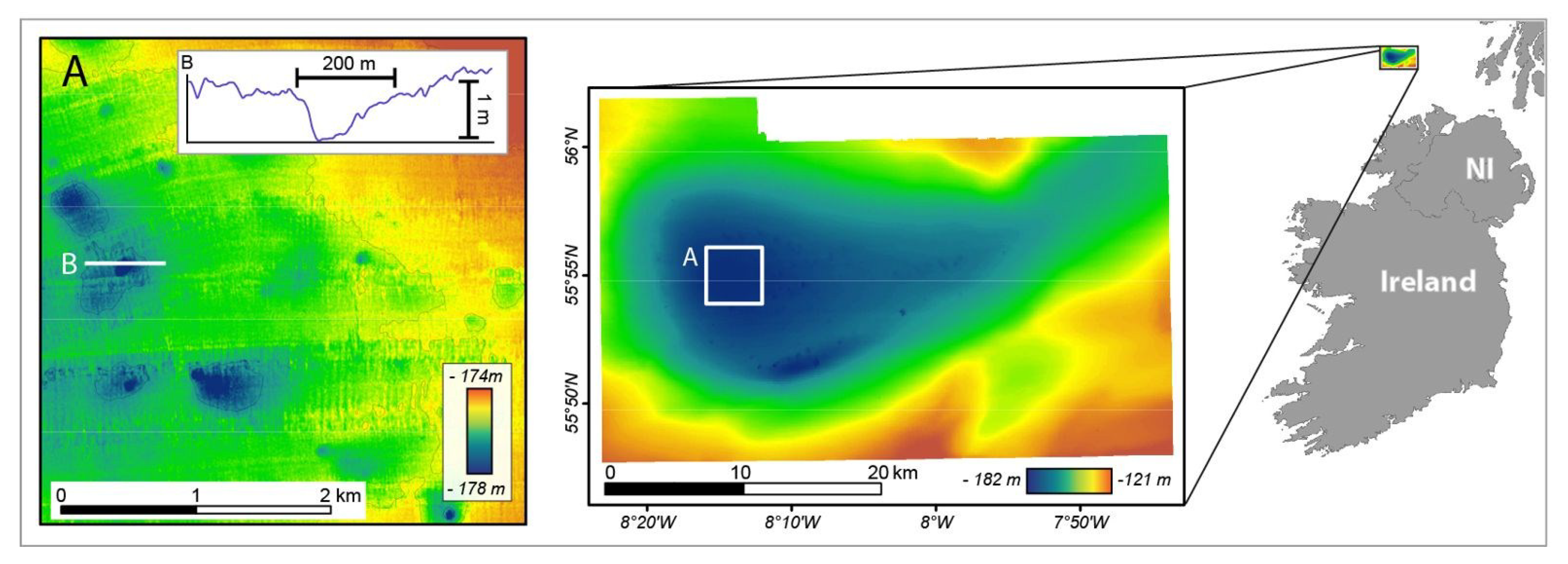
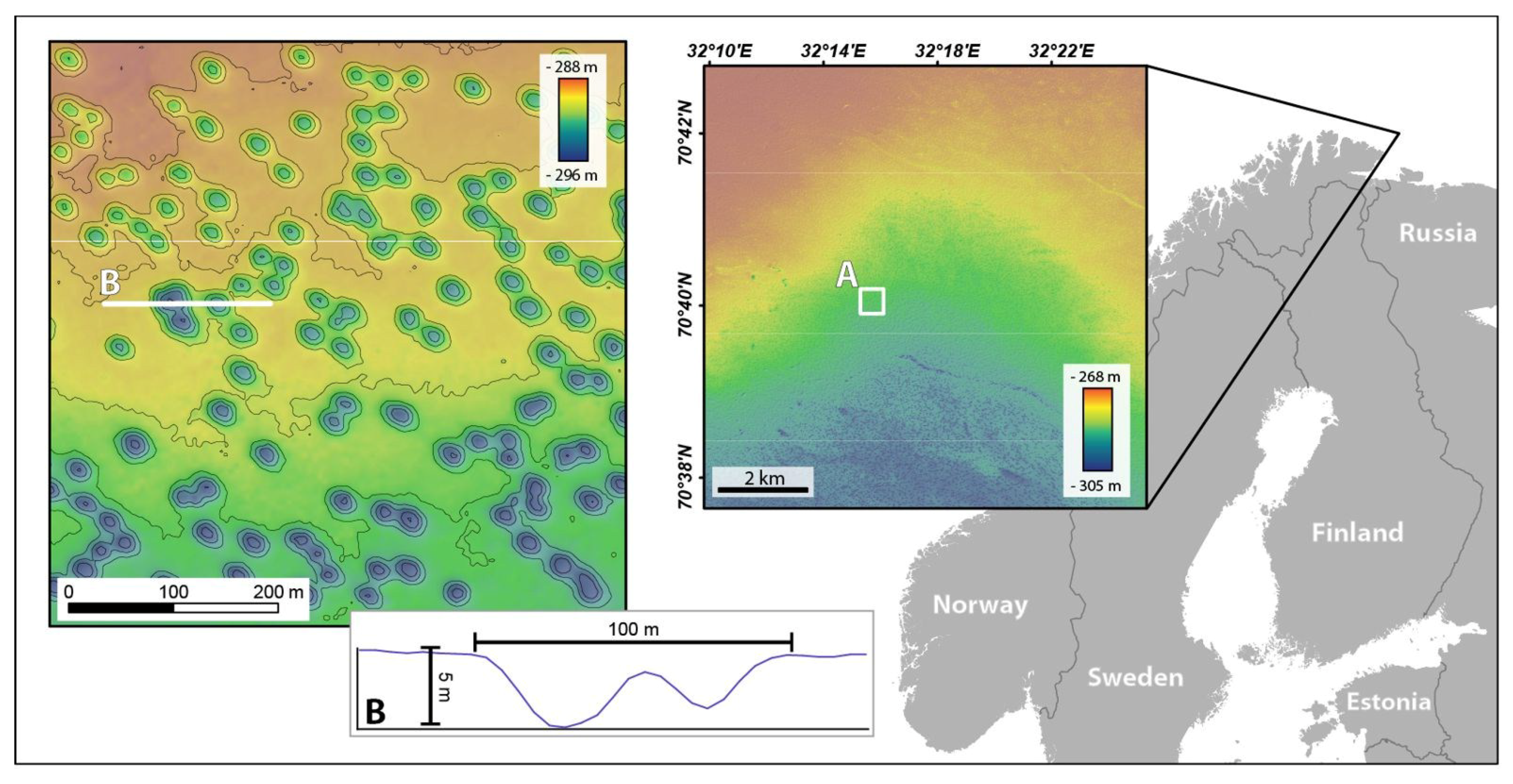
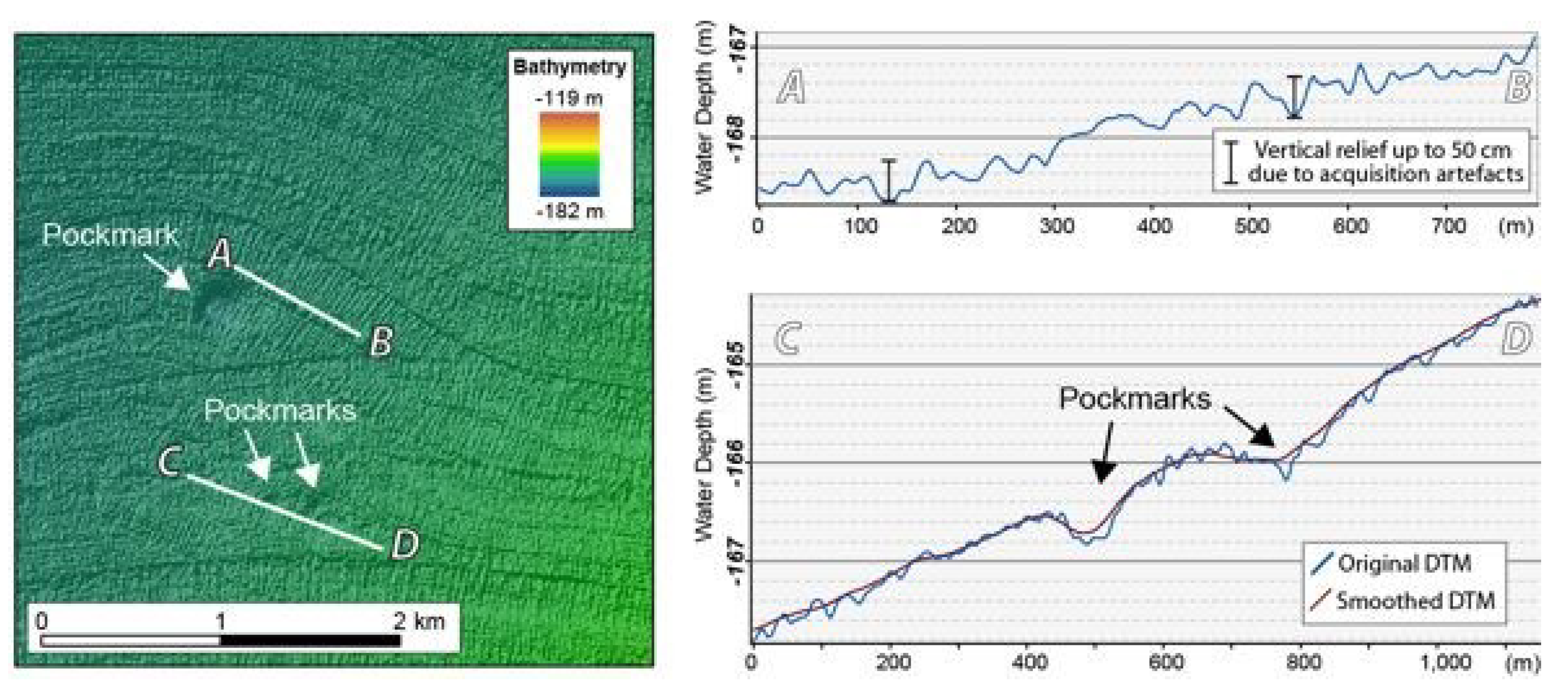



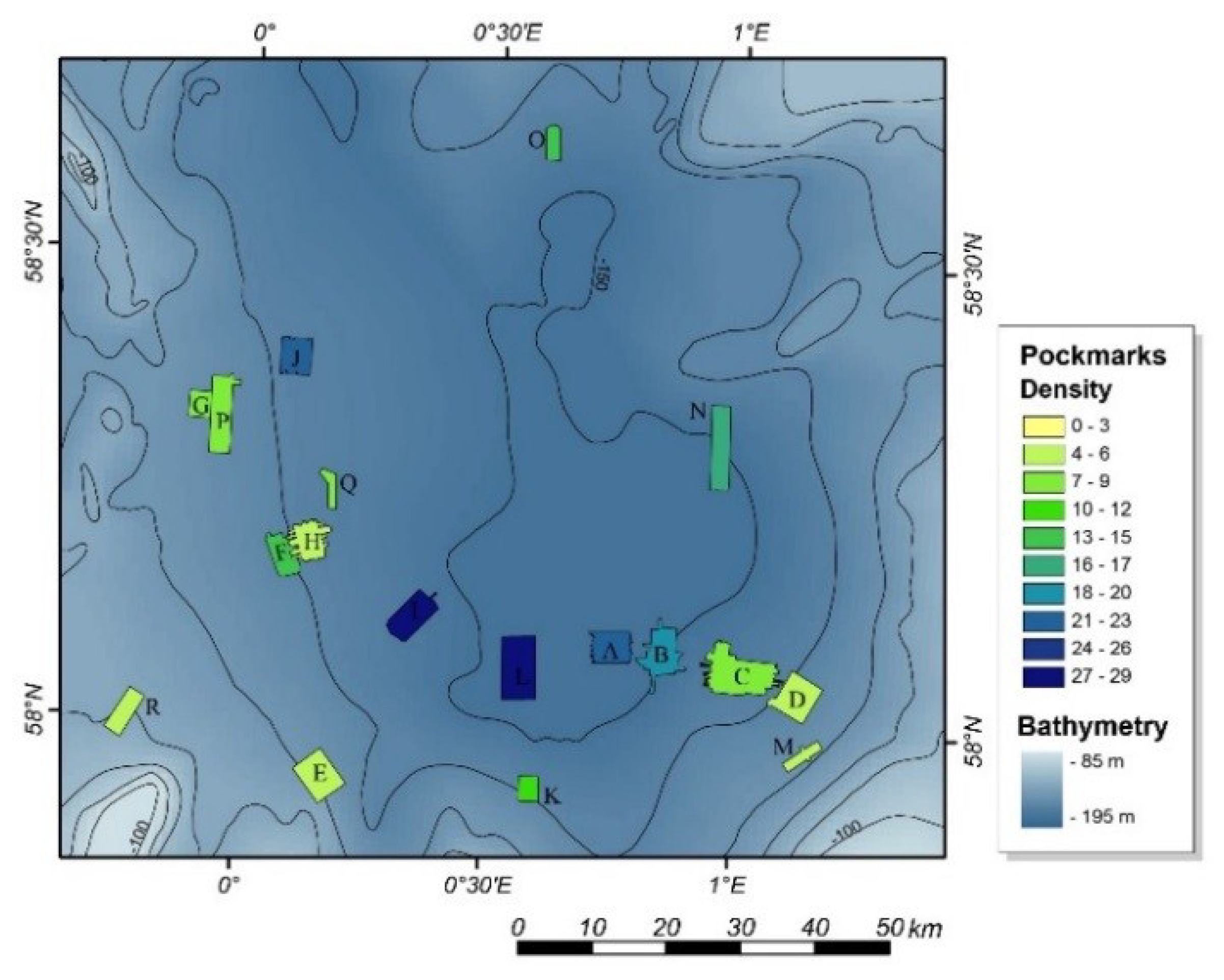
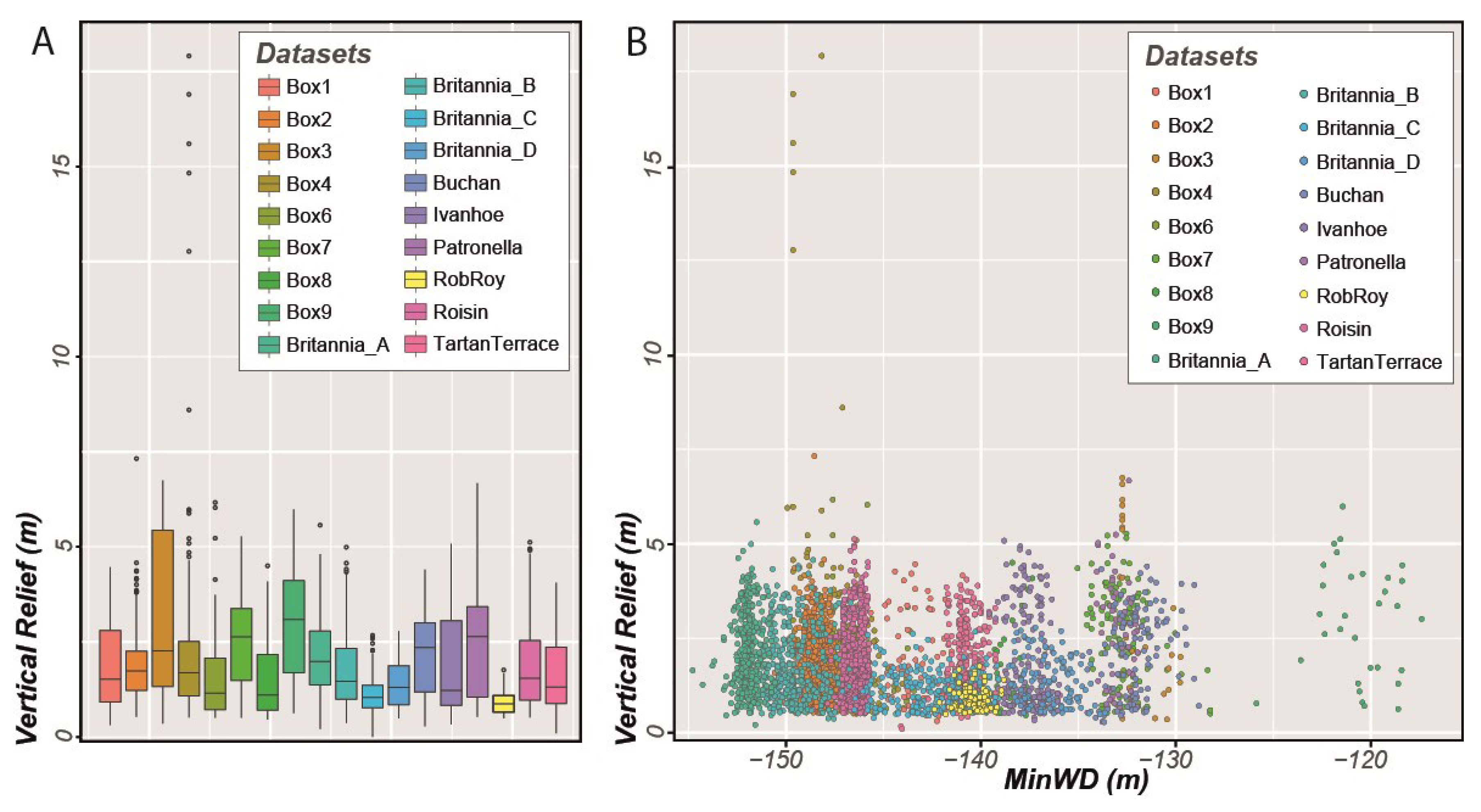
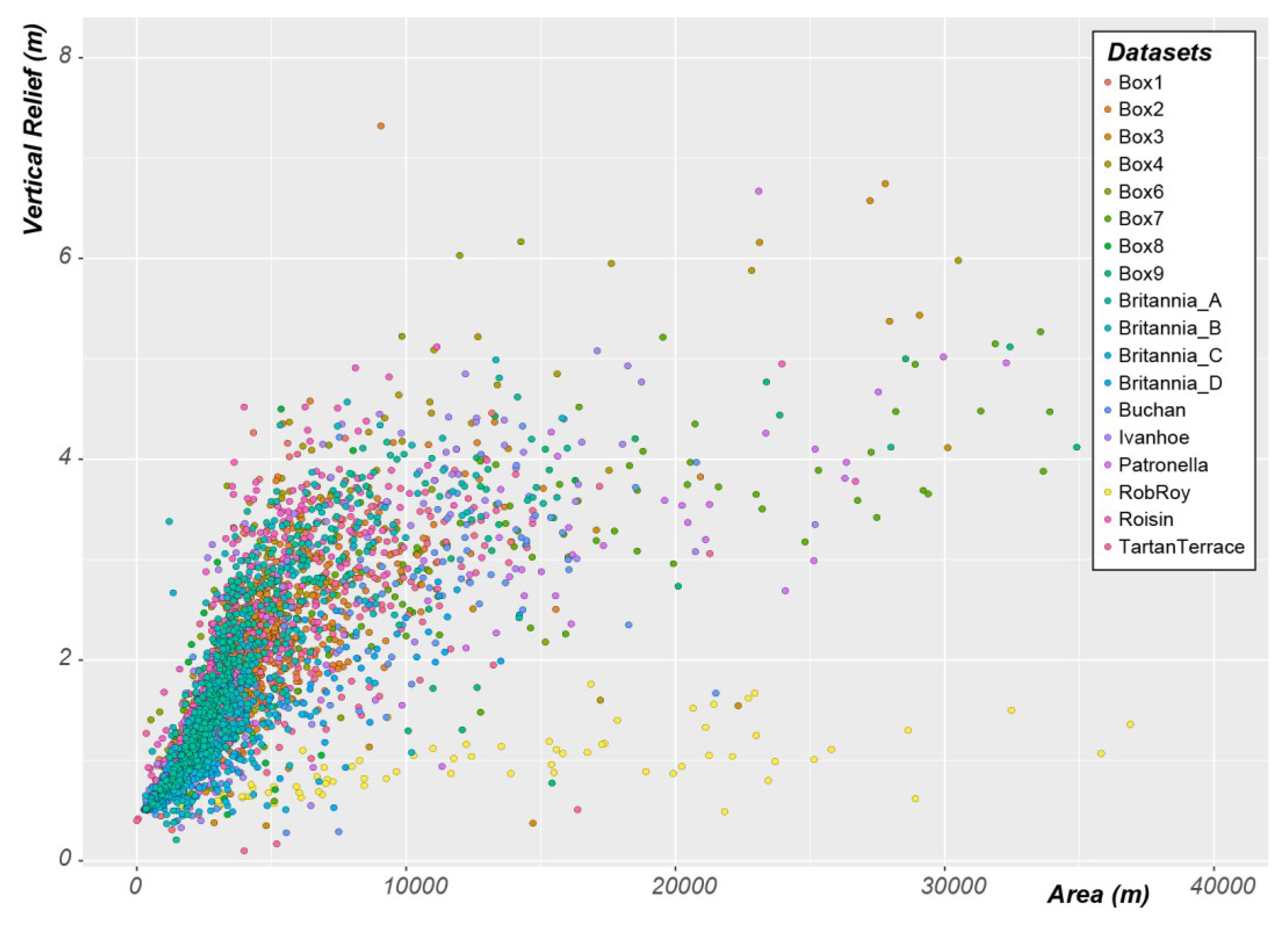
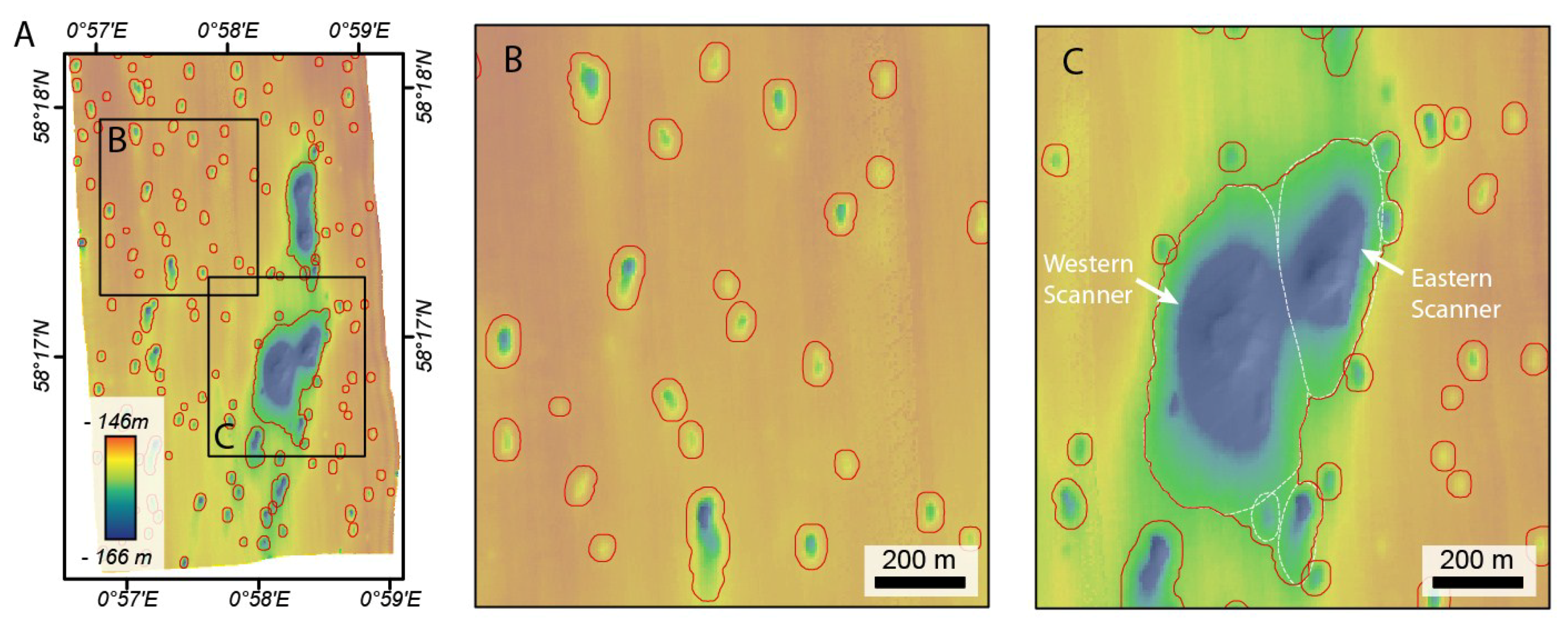
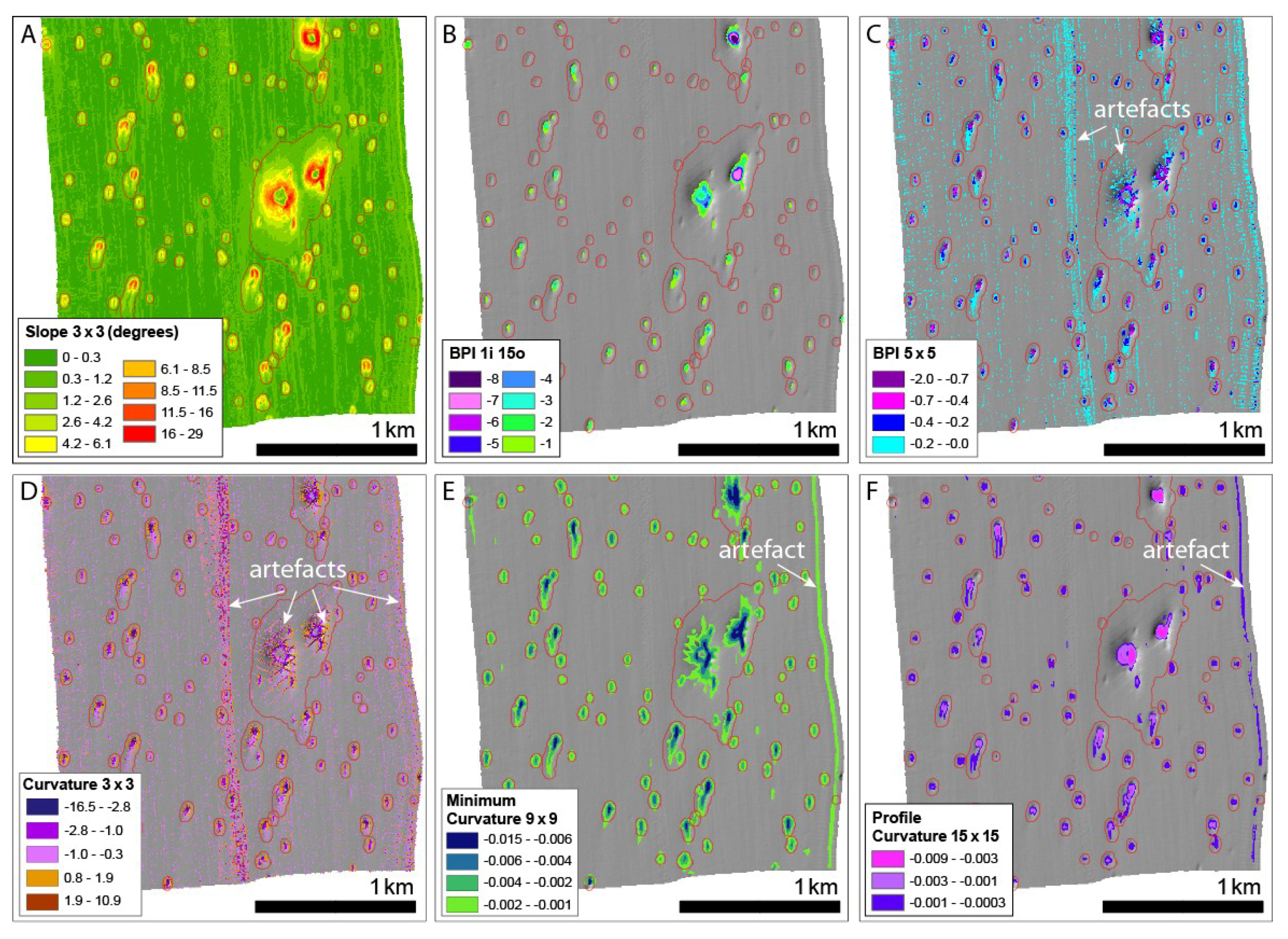
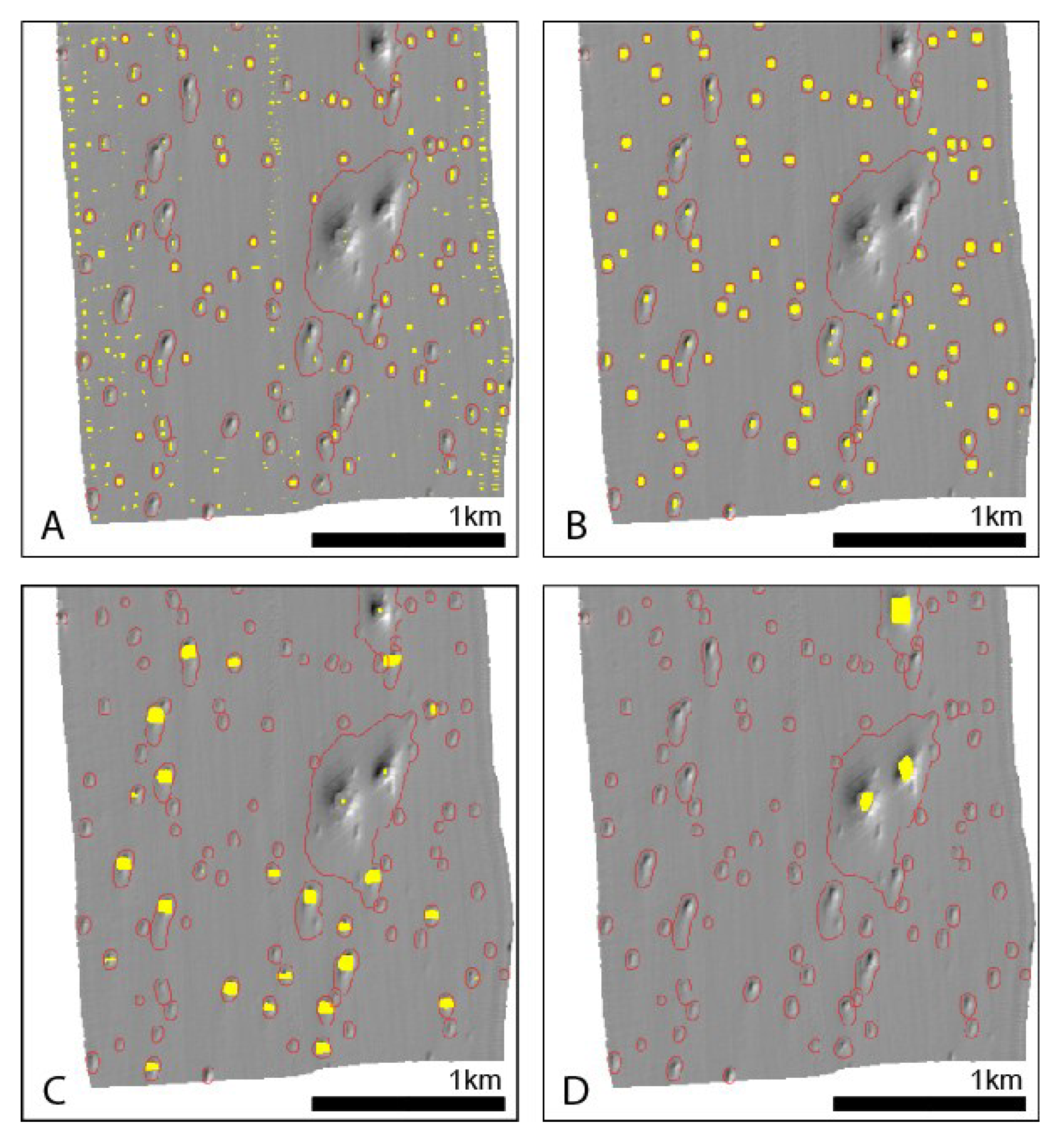
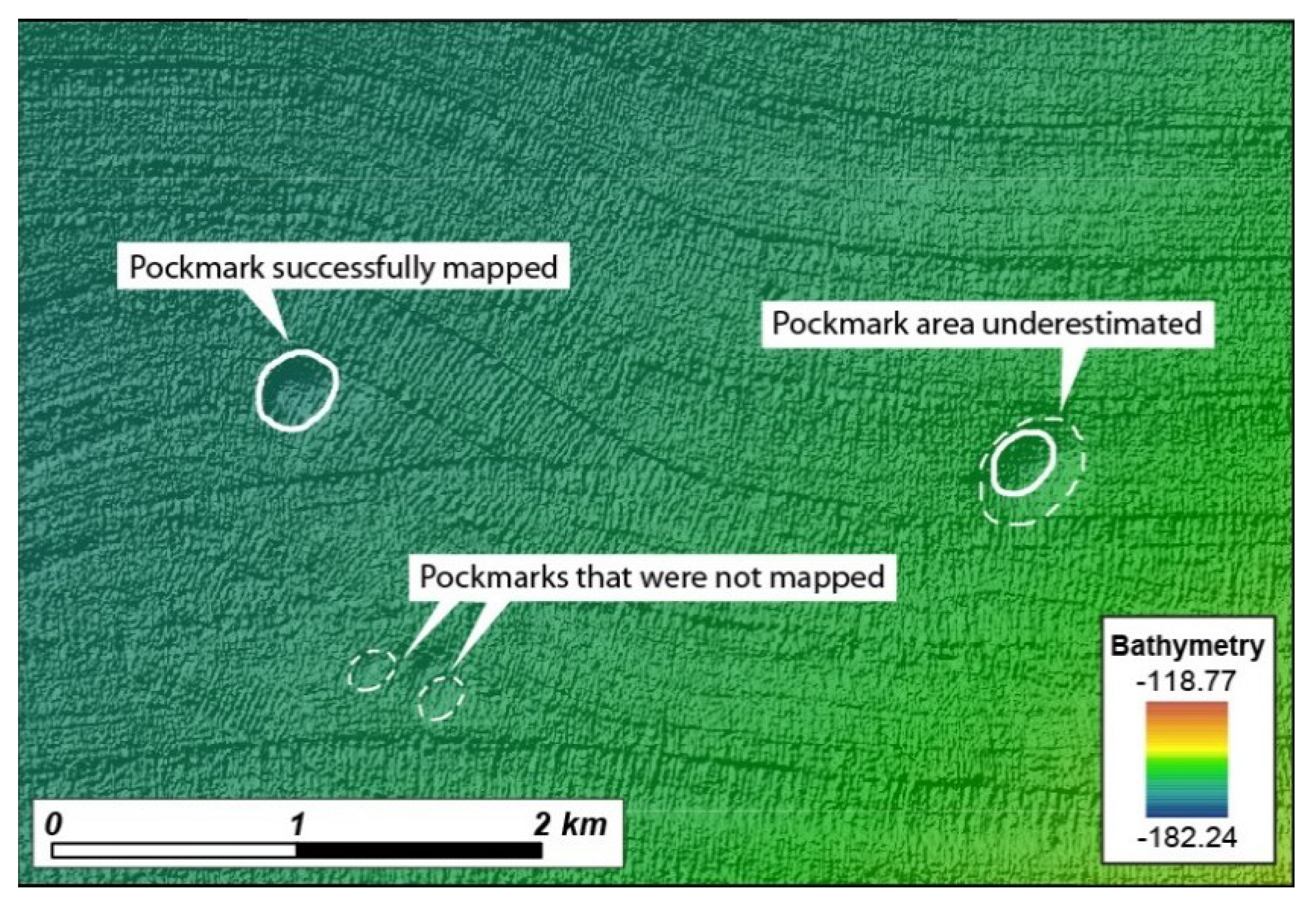
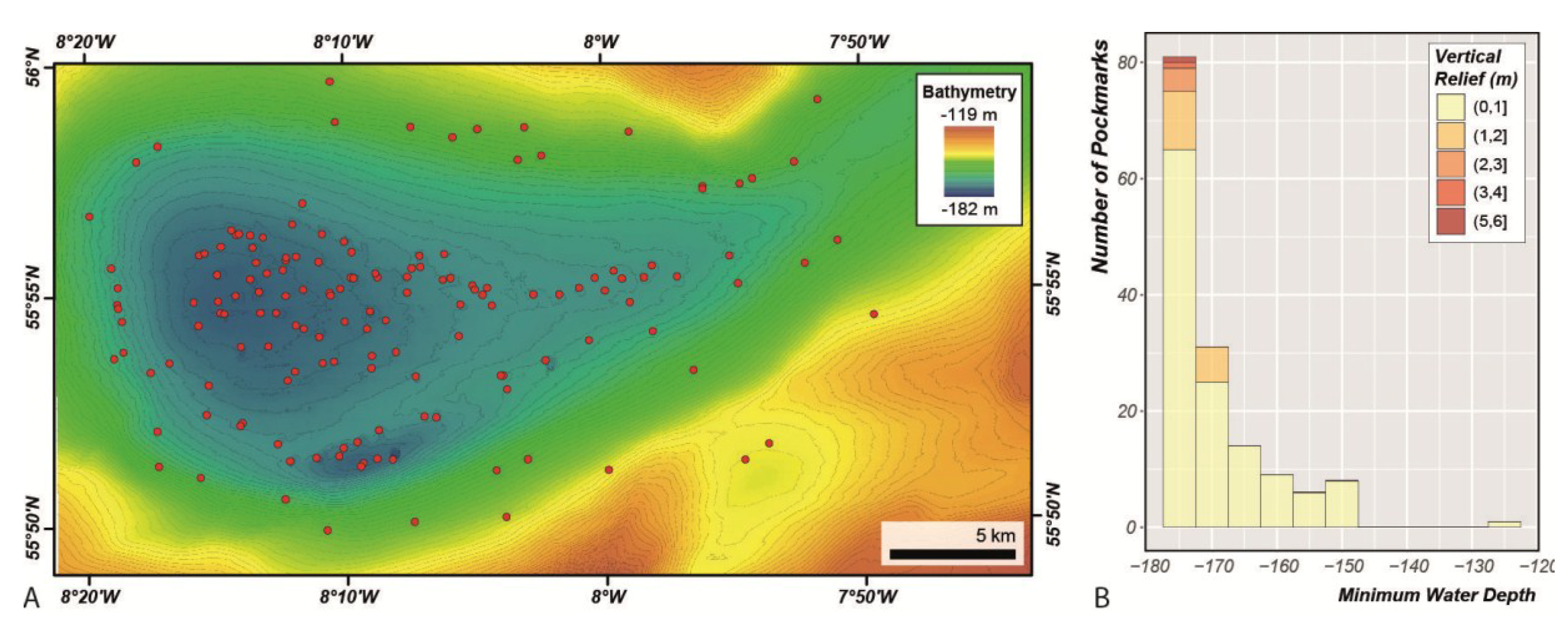
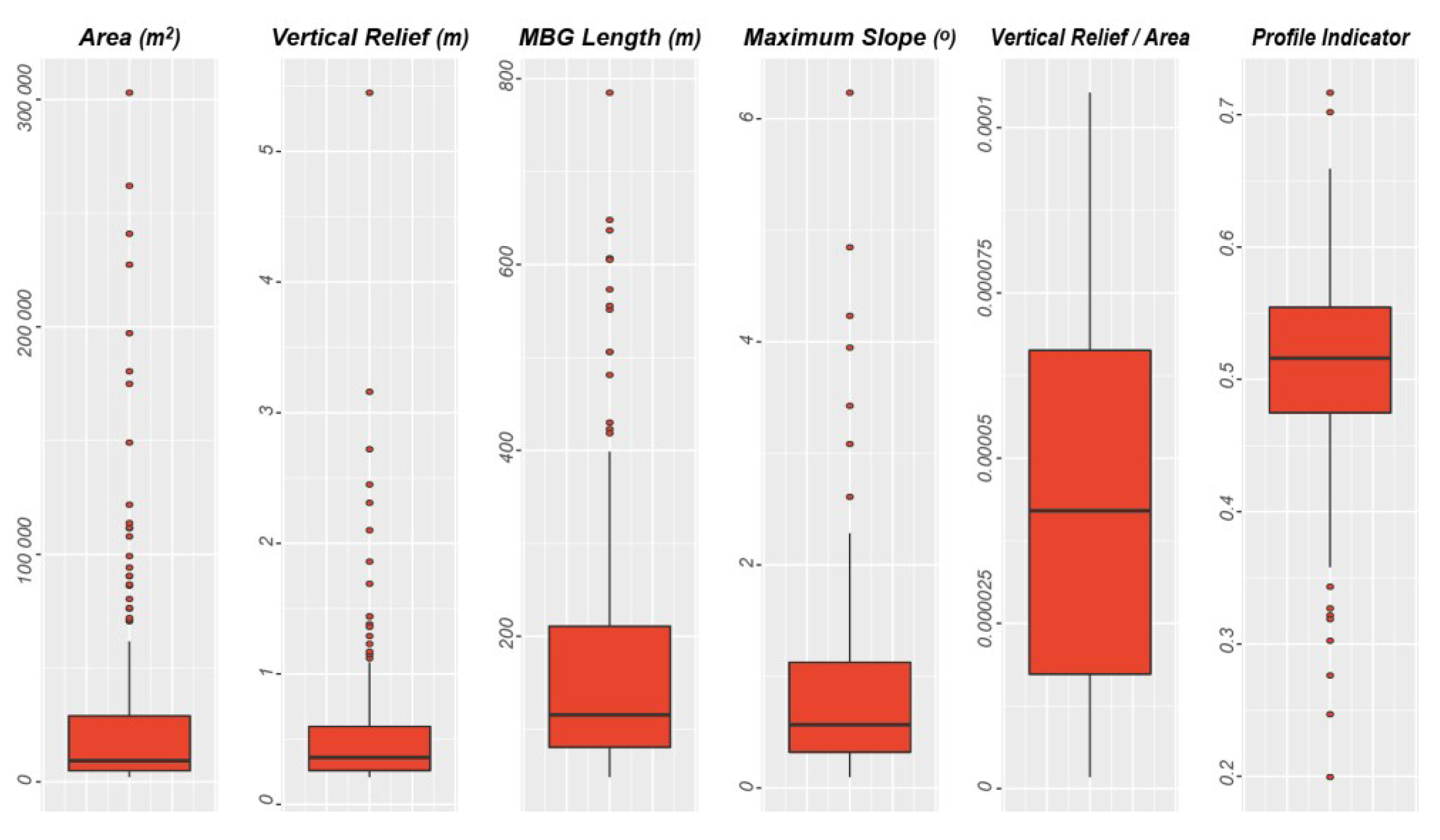
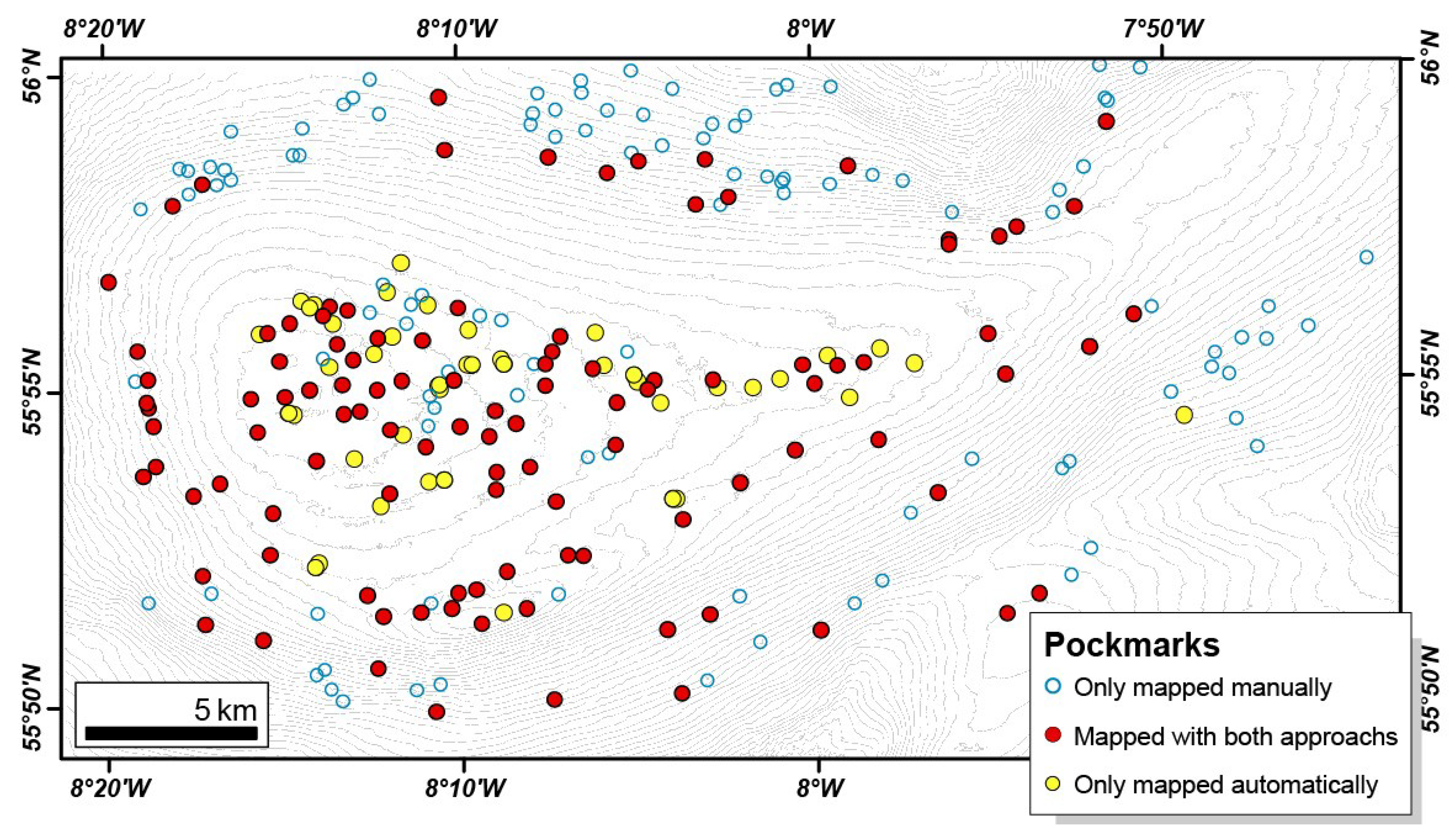

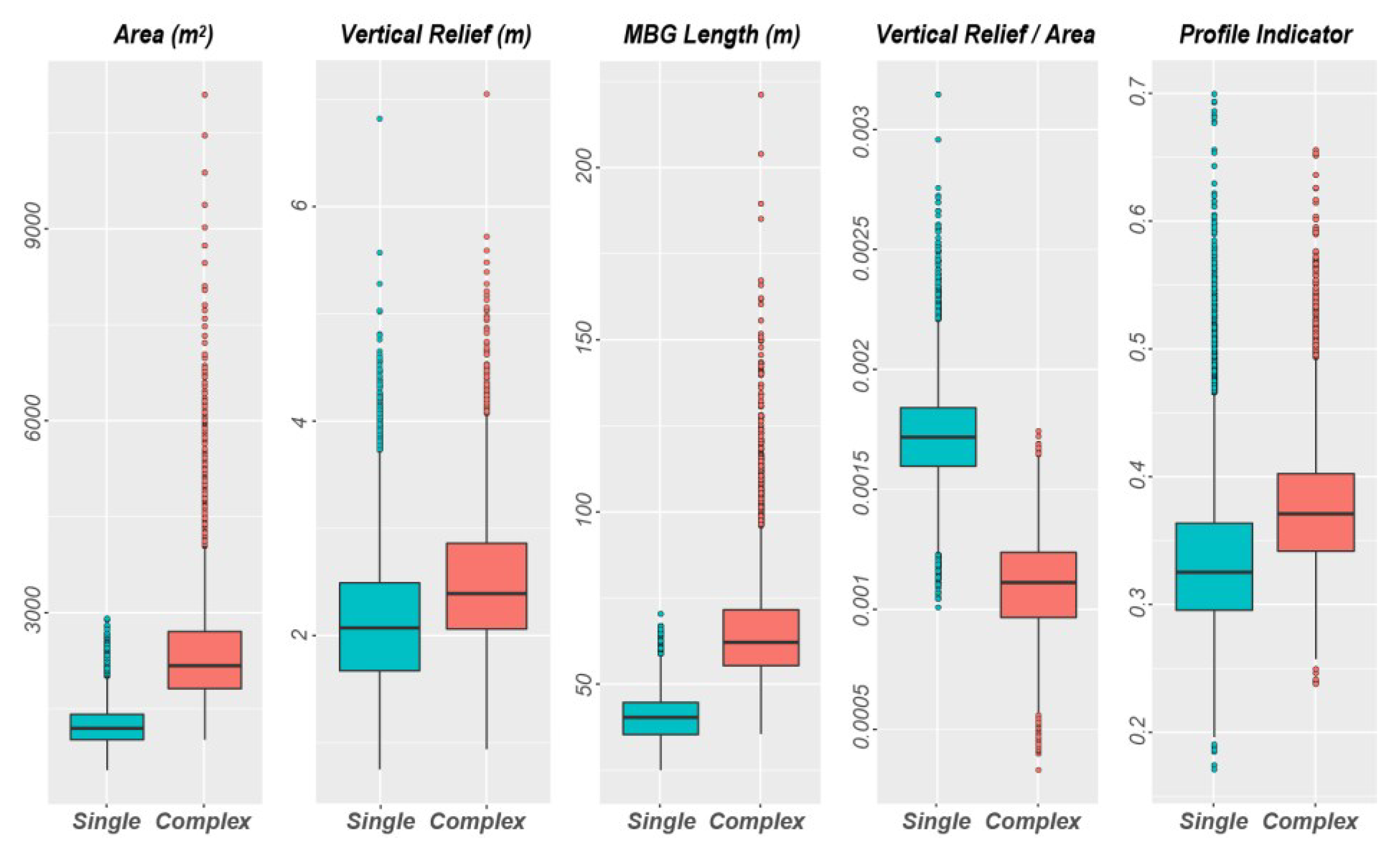
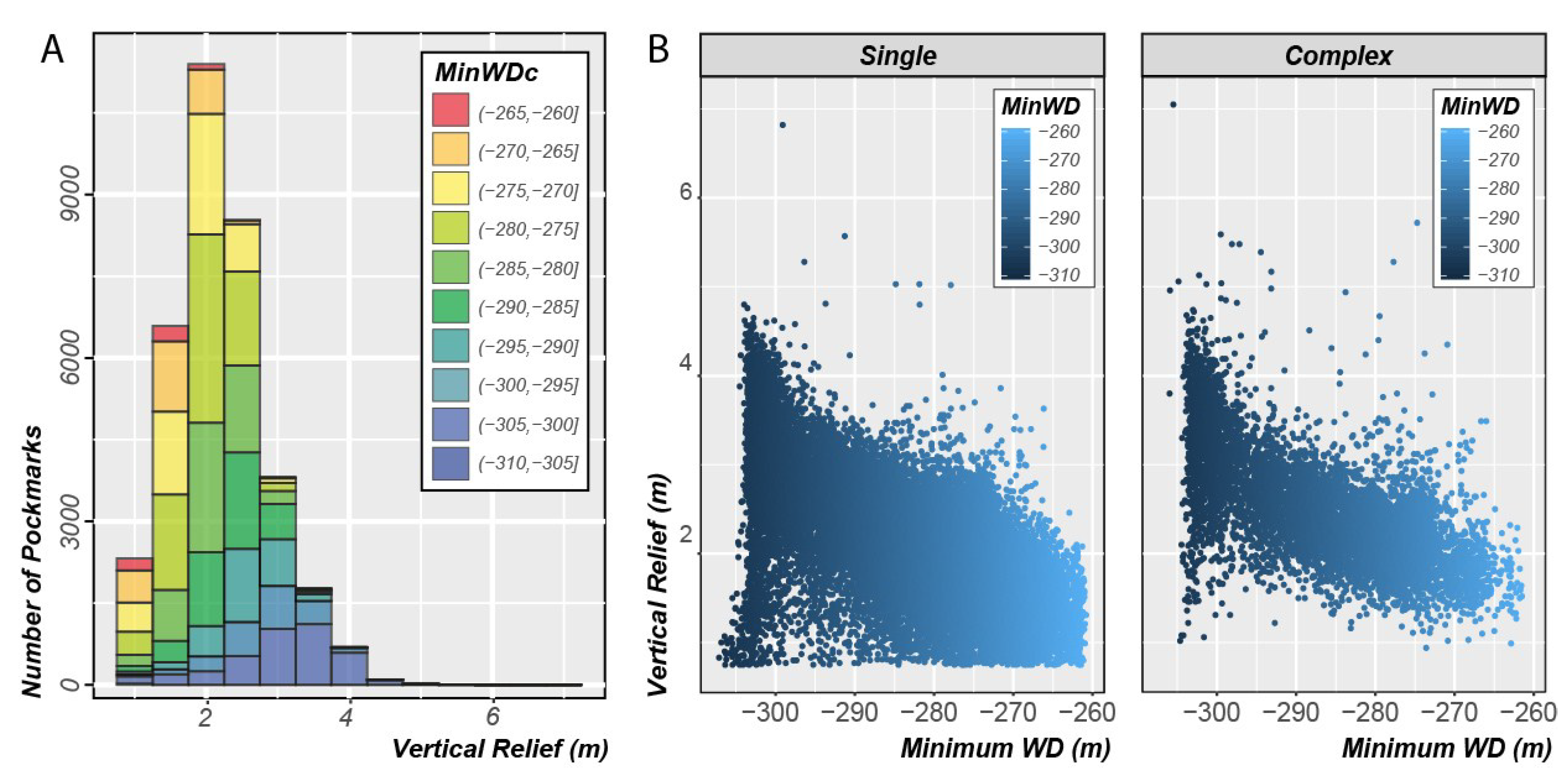
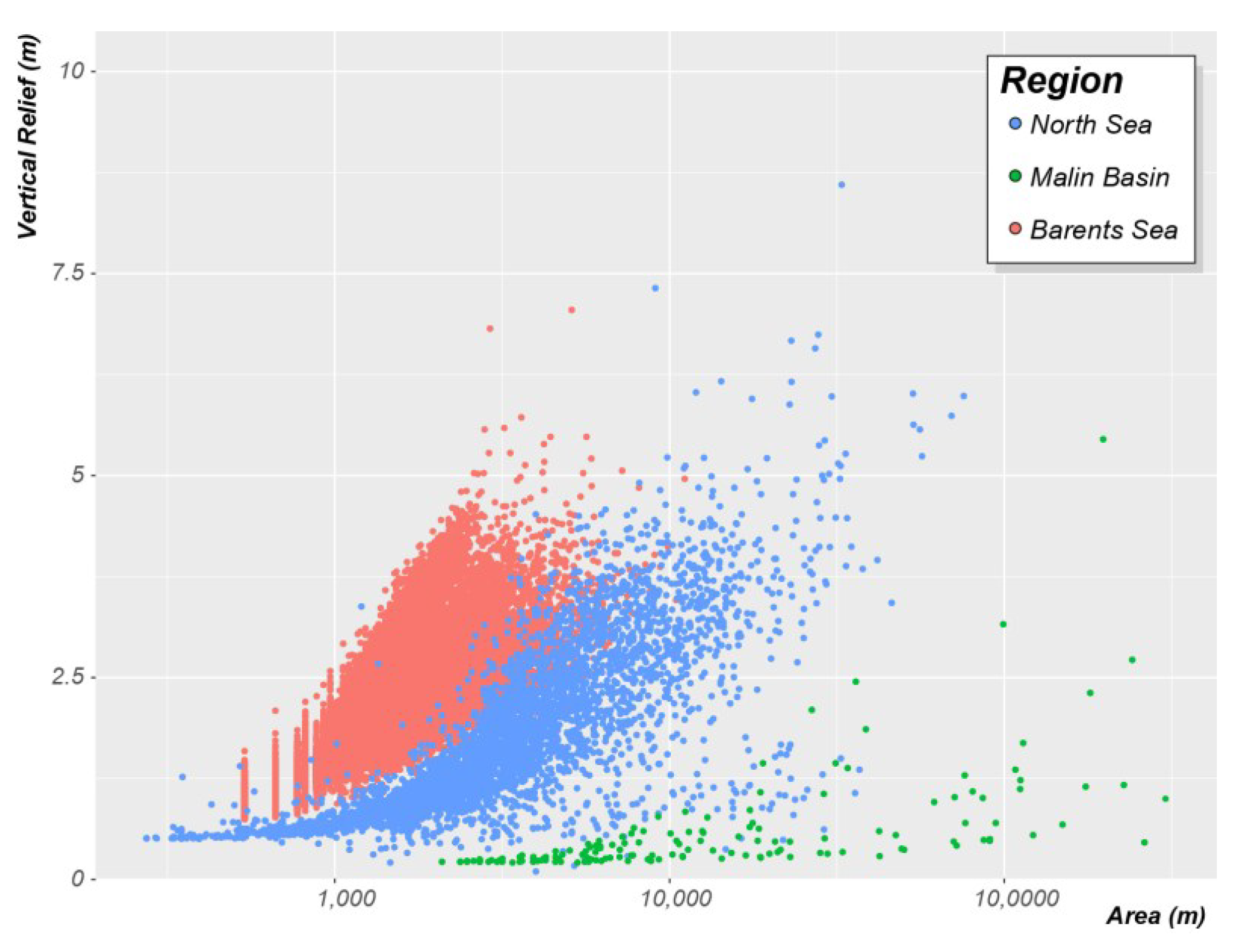


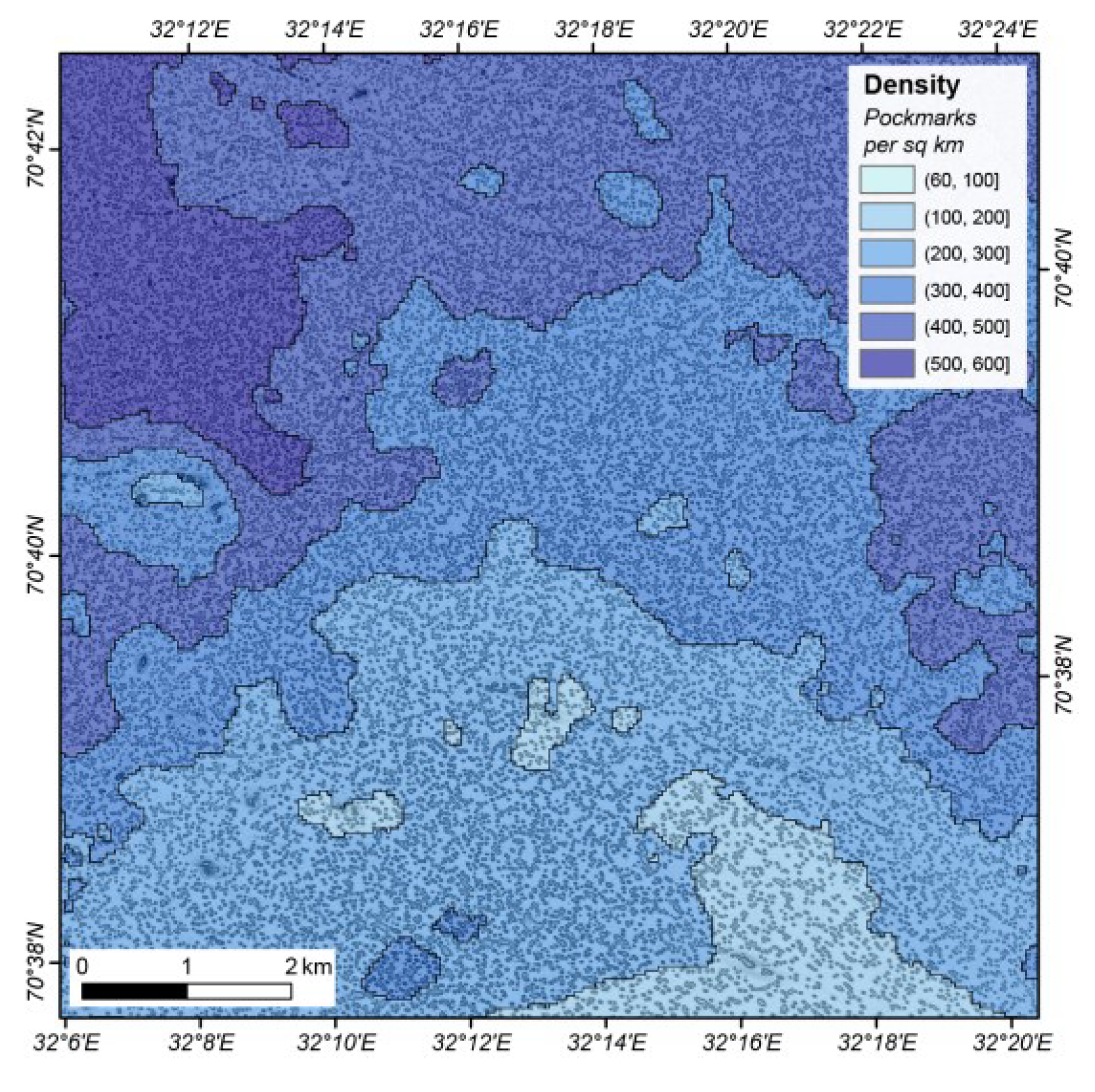
| Terrain Attribute | Analysis Scale Used (Pixel n × n Neighbourhood, Except BPI (BTM Toolbox) | Method |
|---|---|---|
| Single scale slope | n = 3 | Standard 3 × 3 curvature from ArcGIS 10.4.1 Spatial Analyst [20] |
| Multiple scale slope | n = 5, 9, 15 | GRASS module r.param.scale via QGIS 2.18.11 based on the methods of [21]. |
| Multiple scale Bathymetric Position Index (BPI) | Inner radius 1, 3 Outer radius 5, 15 | Fine_scale BPI using the BTM toolbox [22]. Annulus neighbourhood with selected inner and outer radius. Produces integer output. |
| Multiple scale BPI (modified) | n = 5, 9, 15 | This modified version of BPI implemented in ArcGIS Spatial Analyst raster calculator produces a floating-point grid. The computation is similar to that presented by [23] but uses a rectangular neighbourhood to facilitate using the same neighbourhood as other analyses. |
| Curvature | n = 3 | Standard, 3 × 3 curvature from ArcGIS 10.4.1 Spatial Analyst [24]. |
| Multiple scale minimum curvature Multiple scale profile curvature | n = 5, 9, 15 n = 5, 9, 15 | Multiple scale curvature calculated using GRASS module r.param.scale via QGIS 2.18.11 which is based on the methods of [21]. |
| Multiple scale feature classification | n = 9, 15, 27, 51 | Multiple scale feature classification calculated using GRASS module r.param.scale via QGIS 2.18.11 from r.param.scale [21]. |
| Study Area | Cut-off VR | Min VR | Min Width | Min W/L | Buffer Distance |
|---|---|---|---|---|---|
| North Sea | 0.5 m | --- | --- | 0.2 | 7.5 m |
| Malin Basin | 0.2 m | 0.2 m | 40 m | 0.2 | 80 m |
| Barents Sea | 0.75 m | 0.75 m | 4 m | 0.2 | 10 m |
| N | μ Area | μ Width | μ Length | μ W/L | μ VR | |
|---|---|---|---|---|---|---|
| Single Pockmarks | 28,014 | 1223 | 15.5 | 19.4 | 0.82 | 2.12 |
| Complex Pockmarks | 7223 | 2386 | 24.6 | 45.4 | 0.5 | 2.5 |
© 2018 by the authors. Licensee MDPI, Basel, Switzerland. This article is an open access article distributed under the terms and conditions of the Creative Commons Attribution (CC BY) license (http://creativecommons.org/licenses/by/4.0/).
Share and Cite
Gafeira, J.; Dolan, M.F.J.; Monteys, X. Geomorphometric Characterization of Pockmarks by Using a GIS-Based Semi-Automated Toolbox. Geosciences 2018, 8, 154. https://doi.org/10.3390/geosciences8050154
Gafeira J, Dolan MFJ, Monteys X. Geomorphometric Characterization of Pockmarks by Using a GIS-Based Semi-Automated Toolbox. Geosciences. 2018; 8(5):154. https://doi.org/10.3390/geosciences8050154
Chicago/Turabian StyleGafeira, Joana, Margaret F. J. Dolan, and Xavier Monteys. 2018. "Geomorphometric Characterization of Pockmarks by Using a GIS-Based Semi-Automated Toolbox" Geosciences 8, no. 5: 154. https://doi.org/10.3390/geosciences8050154





